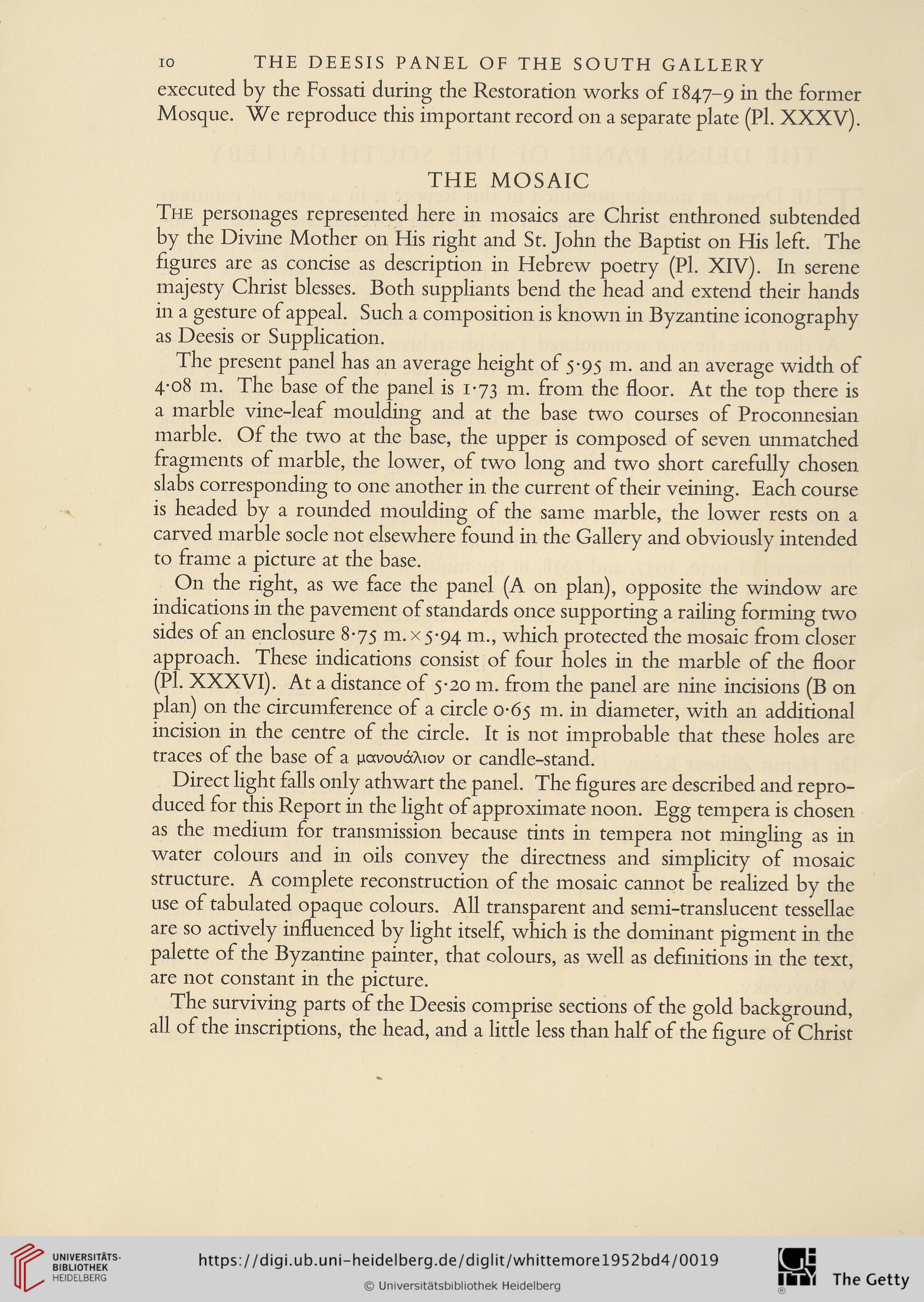10 THE DEESIS PANEL OF THE SOUTH GALLERY
executed by the Fossati during the Restoration works of 1847-9 in the former
Mosque. We reproduce this important record on a separate plate (Pl. XXXV).
THE MOSAIC
The personages represented here in mosaics are Christ enthroned subtended
by the Divine Mother on His right and St. John the Baptist on His left. The
figures are as concise as description in Hebrew poetry (Pl. XIV). In serene
majesty Christ blesses. Both suppliants bend the head and extend their hands
in a gesture of appeal. Such a composition is known in Byzantine iconography
as Deesis or Supplication.
The present panel has an average height of 5-95 m. and an average width of
4-08 m. The base of the panel is 1-73 m. from the floor. At the top there is
a marble vine-leaf moulding and at the base two courses of Proconnesian
marble. Of the two at the base, the upper is composed of seven unmatched
fragments of marble, the lower, of two long and two short carefully chosen
slabs corresponding to one another in the current of their veining. Each course
is headed by a rounded moulding of the same marble, the lower rests on a
carved marble socle not elsewhere found in the Gallery and obviously intended
to frame a picture at the base.
On the right, as we face the panel (A on plan), opposite the window are
indications in the pavement of standards once supporting a railing forming two
sides of an enclosure 8-75 m. x 5-94 m., which protected the mosaic from closer
approach. These indications consist of four holes in the marble of the floor
(Pl. XXXVI). At a distance of 5-20 m. from the panel are nine incisions (B on
plan) on the circumference of a circle 0-65 m. in diameter, with an additional
incision in the centre of the circle. It is not improbable that these holes are
traces of the base of a iiavoudAiov or candle-stand.
Direct light falls only athwart the panel. The figures are described and repro-
duced for this Report in the light of approximate noon. Egg tempera is chosen
as the medium for transmission because tints in tempera not mingling as in
water colours and in oils convey the directness and simplicity of mosaic
structure. A complete reconstruction of the mosaic cannot be realized by the
use of tabulated opaque colours. All transparent and semi-translucent tessellae
are so actively influenced by light itself, which is the dominant pigment in the
palette of the Byzantine painter, that colours, as well as definitions in the text,
are not constant in the picture.
The surviving parts of the Deesis comprise sections of the gold background,
all of the inscriptions, the head, and a little less than half of the figure of Christ
executed by the Fossati during the Restoration works of 1847-9 in the former
Mosque. We reproduce this important record on a separate plate (Pl. XXXV).
THE MOSAIC
The personages represented here in mosaics are Christ enthroned subtended
by the Divine Mother on His right and St. John the Baptist on His left. The
figures are as concise as description in Hebrew poetry (Pl. XIV). In serene
majesty Christ blesses. Both suppliants bend the head and extend their hands
in a gesture of appeal. Such a composition is known in Byzantine iconography
as Deesis or Supplication.
The present panel has an average height of 5-95 m. and an average width of
4-08 m. The base of the panel is 1-73 m. from the floor. At the top there is
a marble vine-leaf moulding and at the base two courses of Proconnesian
marble. Of the two at the base, the upper is composed of seven unmatched
fragments of marble, the lower, of two long and two short carefully chosen
slabs corresponding to one another in the current of their veining. Each course
is headed by a rounded moulding of the same marble, the lower rests on a
carved marble socle not elsewhere found in the Gallery and obviously intended
to frame a picture at the base.
On the right, as we face the panel (A on plan), opposite the window are
indications in the pavement of standards once supporting a railing forming two
sides of an enclosure 8-75 m. x 5-94 m., which protected the mosaic from closer
approach. These indications consist of four holes in the marble of the floor
(Pl. XXXVI). At a distance of 5-20 m. from the panel are nine incisions (B on
plan) on the circumference of a circle 0-65 m. in diameter, with an additional
incision in the centre of the circle. It is not improbable that these holes are
traces of the base of a iiavoudAiov or candle-stand.
Direct light falls only athwart the panel. The figures are described and repro-
duced for this Report in the light of approximate noon. Egg tempera is chosen
as the medium for transmission because tints in tempera not mingling as in
water colours and in oils convey the directness and simplicity of mosaic
structure. A complete reconstruction of the mosaic cannot be realized by the
use of tabulated opaque colours. All transparent and semi-translucent tessellae
are so actively influenced by light itself, which is the dominant pigment in the
palette of the Byzantine painter, that colours, as well as definitions in the text,
are not constant in the picture.
The surviving parts of the Deesis comprise sections of the gold background,
all of the inscriptions, the head, and a little less than half of the figure of Christ




